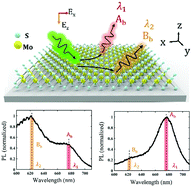Bright excitonic multiplexing mediated by dark exciton transition in two-dimensional TMDCs at room temperature†
Abstract
2D-semiconductors with strong light–matter interaction are attractive materials for integrated and tunable optical devices. Here, we demonstrate room-temperature wavelength multiplexing of the two-primary bright excitonic channels (Ab-, Bb-) in monolayer transition metal dichalcogenides (TMDs) arising from a dark exciton mediated transition. We present how tuning dark excitons via an out-of-plane electric field cedes the system equilibrium from one excitonic channel to the other, encoding the field polarization into wavelength information. In addition, we demonstrate how such exciton multiplexing is dictated by thermal-scattering by performing temperature dependent photoluminescence measurements. Finally, we demonstrate experimentally and theoretically how excitonic mixing can explain preferable decay through dark states in MoX2 in comparison with WX2 monolayers. Such field polarization-based manipulation of excitonic transitions can pave the way for novel photonic device architectures.

- This article is part of the themed collections: Materials Horizons Emerging Investigators Series 2022/2023 and Materials Horizons 10th anniversary regional spotlight collection: Africa and the Middle East


 Please wait while we load your content...
Please wait while we load your content...